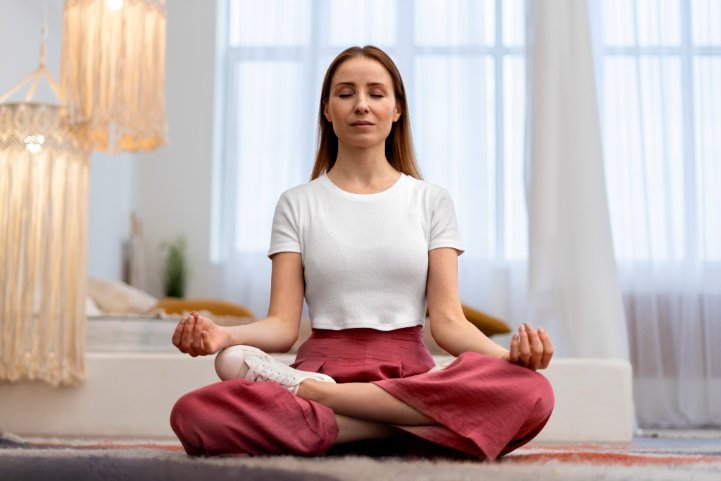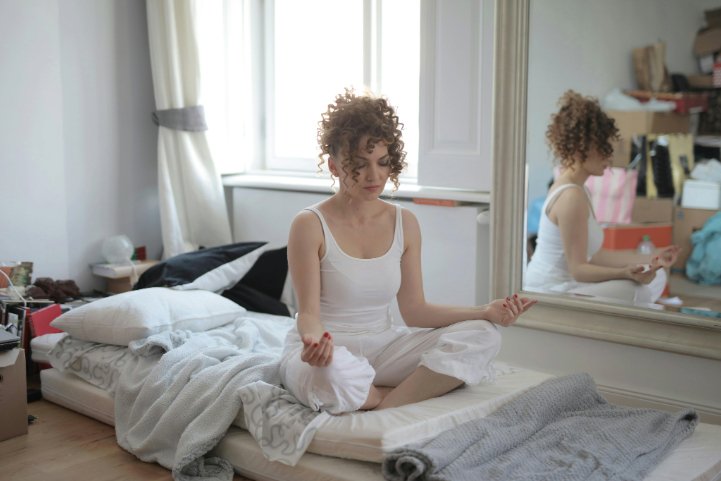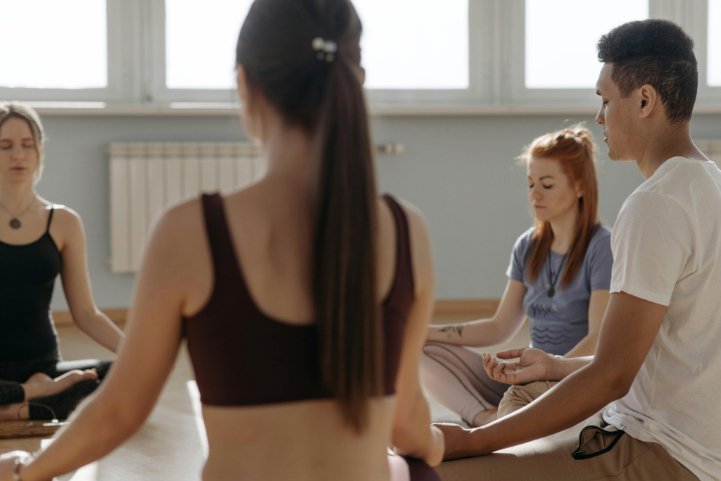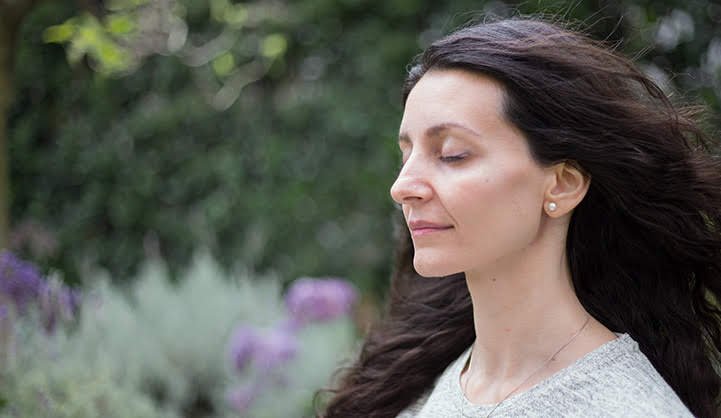
Beginners Guide
Learn practical tips to establish a consistent meditation routine with all the benefits, even for the busiest people. Start your meditation journey today!
“How do I start meditating?” This question probably crossed your mind when you downloaded a popular meditation app. Meditation resources are everywhere now. Headspace and Calm have garnered 65 million and 200 million downloads, respectively. Yet the numbers tell an interesting story – all but one of these users fail to participate enough to see real benefits.
These numbers paint a concerning picture, given the stakes involved. Research proves that mindfulness meditation can lower blood pressure and reduce anxiety, depression, and insomnia symptoms. Studies also show that more frequent and longer meditation sessions bring greater health benefits to both clinical and general adult populations.
The path to a lasting meditation routine isn’t always smooth. Like many others, I’ve struggled to stay consistent. Time constraints, technique selection, and restlessness can quickly derail your intentions.
The good news? You don’t need countless hours or decades of practice to meditate effectively. This piece provides straightforward, practical steps that blend seamlessly into your busy schedule and help you establish an eco-friendly practice. Let’s explore strategies that work for people living busy lives.

Many people think they need huge time blocks to start meditating and see results. This stops busy people from taking the first step. Here’s the good news: research shows that even brief meditation sessions can make a significant difference.
Five minutes might seem too short, but new meditators find it works really well. Research shows that just five minutes of daily meditation can significantly reduce stress and help people manage their emotions more effectively. A 2015 study involving 61 mental health professionals found that five minutes of daily meditation for one week resulted in significant reductions in stress.
It also turns out that short bursts of meditation work just as well as longer sessions. Scientists found that four 5-minute mindfulness practices worked as effectively as four 20-minute ones to improve depression, anxiety, and stress. So starting with brief sessions removes a major roadblock—the time people think they need to commit.
People call meditation “a push-up for the brain” because it helps improve cognitive control and strengthens brain connections. Five minutes gives you just enough time to get comfortable with silence and learn about yourself if you’re new to this experience.
These quick sessions can bring noticeable benefits fast. Studies reveal that regular practice helps ease anxiety and boosts mood and focus within days. After trying a few 5-minute sessions, you’ll find it easier to build a daily practice that unlocks even more benefits.
The real magic of meditation isn’t about how long you sit—it’s about how often you do it. A review of over 200 trials found no evidence that longer sessions were more effective than shorter ones. Instead, people who meditated more frequently got better results.
This idea aligns with the “marginal gains” concept commonly applied in high-performance sports and business. Small improvements in everything you do can lead to big wins over time. With meditation, a short daily practice creates powerful, lasting effects.
BJ Fogg, who studies behavior, explains why daily meditation can be tough: “When you form a new habit, if you feel successful as you do it, the habit will wire in. Most of the time when we meditate, we’re not feeling successful”. The solution? Start with what Fogg calls a “Tiny Habit”—something quick that takes less than 30 seconds, like three calming breaths.
Regular practice matters more than length, especially when you’re starting out. Three minutes of consistent meditation beats trying for an hour and giving up. Your routine becomes solid, and then you can gradually increase from three minutes to five, then ten, and continue growing.
One meditator learned this firsthand: “By day four, I kind of craved that bout of ‘me’ time before hitting the shower, turning on the Keurig, and starting my day”. She felt less stressed after just two days of morning meditation. By day three, she handled mental challenges better during marathon training.
To build consistency:
Note that five minutes every day works way better than thirty minutes once a week. Success comes from showing up regularly and letting those small sessions change your digital world.

The right time to meditate plays a vital role in building a lasting practice. Meditation can be practiced at any hour, but choosing a time that aligns with your natural rhythm helps you stick with it for longer.
Morning meditation comes with clear benefits. The early hours (between 4:00 AM and 6:00 AM) are known as the “amrit vela” or ambrosial hours. These hours give you deep peace while the world sleeps. Your mind stays calmer then, without the day’s mental baggage.
Starting your day with meditation sets the tone for everything else. One practitioner said, “By day four, I kind of craved that bout of ‘me’ time before hitting the shower”. Meditation becomes part of your morning routine and doesn’t get pushed aside by other tasks.
Evening meditation creates a natural divide between work and personal life. This switch helps you:
Many people find 6 PM sessions work well between professional and personal time. Nevertheless, it is recommended to finish meditating 30-60 minutes before bed to avoid mixing meditation with sleep.
The largest longitudinal study comparing morning and evening meditation revealed an interesting finding. Morning meditators sustained their practice over a long period in the short and medium term. People with flexible timing stuck with it the longest overall. This suggests that strict scheduling may be effective initially, but flexibility is what keeps you going throughout your life.
You can build a meditation practice by connecting it to activities you already do. This method uses “anchor habits” – existing routines that trigger your meditation practice.
To name just one example, see these options:
Studies show that anchor habits are an effective way to achieve results. Once meditation becomes part of your daily routine, skipping it feels strange. This approach builds on your brain’s existing patterns instead of creating new ones.
Your unique energy patterns matter too. Forcing a morning meditation might stress you out if your mornings feel rushed. One meditation teacher says, “If you cannot do it in the morning or in the evening, you can find some time during your day to meditate for a few minutes”.
The calendar method provides an additional practical approach. Block meditation time like you would a fitness class. Scheduling creates both commitment and accountability.
Consistency matters more than timing through this journey. “Meditating every day and working to be consistent is the most important aspect of building the habit and your meditation practice”. One person shared, “I managed to control my willpower, and in the last six months I managed to keep meditating for forty-five minutes every day… And I can’t even begin to tell you how this habit changed my life.”
Your personal experience matters most. Research examines large groups, but your individual results are more important. Notice when meditation feels most helpful and sustainable in your life.

A dedicated meditation space acts as a powerful anchor for your practice. Athletes have their training facilities, and writers have their offices. Meditators need a consistent spot that tells their brain: “It’s time to be still.” Your mind will slip into a meditative state more easily when it connects a specific place with the activity.
The right location can significantly enhance your meditation practice. You don’t need to dedicate an entire room—a small, well-laid-out corner can become your mindfulness sanctuary. Here are the main things to think about when picking your spot:
Quietness level – Pick the quietest area in your home, away from:
Test potential locations by sitting quietly for 10-15 minutes. This helps you check noise levels, lighting changes, and overall comfort. The timing matters too—if your neighborhood gets quiet during certain hours, plan your practice then.
Natural light offers numerous benefits, particularly when meditating near a window. Light, airy curtains can soften sunlight and create a calming effect. This connection to the outside world enhances the meditative experience.
Of course, comfort plays a huge role. Your meditation area should feel welcoming and support your body. A cushion or chair should give proper support for your posture. Any discomfort will distract you more as time passes, so good seating becomes crucial for longer sessions.
New meditators often struggle with external distractions. These practical strategies can help create a more focused environment:
Sound management techniques:
Clear boundaries with people at home matter just as much. Tell your family or housemates about your meditation schedule. A simple note on the door works as a good reminder. Noise-canceling headphones can help if you share living spaces and can’t find quiet easily.
Clutter can pull your focus away. Keep your meditation space clean and tidy, removing any distractions that could hinder your practice. This means no electronics, paperwork, or other stress-inducing items in your line of sight.
A portable meditation kit works well if you have limited space. Put your meditation essentials in a small basket that you can set up on your bed or coffee table whenever needed. This provides flexibility while retaining the benefits of a dedicated practice area.
The same spot strengthens your meditation habit over time. You’ll start to associate that place with meditation, which makes it easier to maintain your practice. This space connection, combined with regular timing, reinforces your meditation habit strongly.
Setting up a dedicated meditation space—even a modest one—shows your physical commitment to practice. This real investment often leads to stronger mental commitment and answers the basic question: “How do I start meditating?” The right environment marks the beginning of your journey.

Simple techniques form the foundation of meditation that works. Most meditation experts recommend starting with straightforward methods rather than complex practices that might overwhelm beginners. These foundational approaches provide immediate benefits and help build skills for more advanced practice.
Breath awareness is the easiest way to start meditating. Find a comfortable seated position with your spine straight and aligned. Close your eyes or lower your gaze, then focus on your natural breathing without trying to control it.
You’ll notice your mind wandering. Thoughts will come up – that’s normal. Simply acknowledge them without judgment and refocus your attention on your breath. This practice helps build attention and teaches you to observe thoughts without getting entangled in them.
Studies have linked breath-focused meditation to improved attention and brain health. Research shows that regular breath meditation can reduce stress and promote relaxation immediately. Start with 10 minutes in the morning and evening. You can increase the duration as you get comfortable.
Body scanning is another available technique that connects the mind with the body. This practice involves moving your attention through each part of your body and noticing sensations without trying to change them.
Here’s how to practice:
When you practice this technique and incorporate it into your self-care routine, your nervous system starts to remember how to relax. It becomes easier for you to come out of sympathetic fight-or-flight mode and instead move into parasympathetic mode, which is the ‘rest-and-digest mode’.
Body scan practice develops present-moment awareness that helps when emotions feel overwhelming. You learn to explore both pleasant and unpleasant sensations, which teaches you to stay present even during discomfort.
Starting your meditation journey means choosing between guided and unguided approaches.
Guided meditation means following instructions from a teacher, app, or recording. We recommend this structured approach for beginners because it provides clear direction and guidance. “Guided meditation is a powerful technique to promote overall wellness and is useful to help you ease into the practice of meditation, particularly for those who struggle to focus and relax on their own”.
Unguided meditation refers to practicing meditation independently without external guidance. You get more freedom to develop personal techniques for focus and relaxation. One practitioner notes, “By staying in the moment with yourself, you can tune into that divine energy, develop a greater sensitivity to your inner space, enter a deep state of surrender and silence, and let the energy of meditation lead you”.
Research doesn’t favor either approach. “There is no evidence to suggest that one form is more effective than the other, and the choice between guided and unguided meditation depends on individual priorities, needs, and experience levels”.
Many experienced meditators recommend a mixed approach—begin with guided sessions to develop core skills, then gradually add unguided practice. “Try doing a mix of unguided and guided. This has been my go-to for years and what I do pretty much daily in my personal practice”.
Your choice of technique matters less than staying consistent. These straightforward approaches provide you with everything needed to start experiencing the benefits of meditation right away.

Tracking your meditation helps you learn about your progress without putting extra pressure on your practice. Many beginners ask, “How do I start meditating effectively?” The answer lies in finding ways to track progress that motivate you without becoming overwhelming.
The digital world offers many tools to support your meditation practice. Apps like Insight Timer, Calm, Headspace, and Sattva guide you through meditation programs and track your duration, frequency, and post-meditation mood. These digital tools show your progress clearly as you look back at your last week, month, or year.
The Healthy Minds Program stands out by letting you customize your practice. You can set session lengths in five-minute increments, select different teachers, and track your progress through features like “current practice streak”. Seeing your consecutive meditation days builds momentum—you’ll want to keep the streak going once you start.
The Art of Living Journey app is a curated, customizable support system designed especially for graduates of the Art of Living Part 1 Course, where participants learn multiple breath-based techniques that can be used on a daily basis.
Traditional meditation journals are more effective if you prefer to stay away from screens. These journals help you:
The best part about tracking, regardless of the method you choose, is how it fosters consistency and self-understanding. One practitioner says, “The continual feedback cycle of journaling doesn’t need to be complete—a sentence or two can beautifully capture the theme of a day or a poignant moment”.
Select a tracking method that aligns with your priorities. Some people add affirmations to their trackers as daily reminders of their intentions, which strengthens their commitment. Others make tracking more inspiring by using their favorite colors and images.
Your accomplishments, big or small, positively affect your meditation experience. Brain research shows that celebrating small wins is “the quickest way to re-wire the brain”. This practice creates “a feeling of pride and happiness factor, which boosts our internal motivation”.
A “win” means something different to everyone. New meditators might celebrate:
Science backs up the power of celebration. “There’s a reason for victory dances,” experts say. “Moving the body in new ways energizes us, builds confidence, and raises our mood. Movement gives our brains positive feedback”.
These celebrations help strengthen your meditation habit. You might set small rewards for achieving specific goals, such as meditating for 30 consecutive days. Before you dismiss these moments as unimportant, note that “small wins build confidence and motivation” and are “the foundations of bigger transformations”.
Try making a daily list of wins or writing down one or two accomplishments each day. “Writing confirms your progress, even if you keep the list private”. This helps you focus on what you’ve achieved instead of what’s left undone.
Your meditation practice grows stronger when tracking and celebrating progress supports your path to mindfulness without getting in the way.

A support network makes meditation more powerful by turning a solo practice into a shared trip. Studies show that meditating with others builds camaraderie, helps you feel less isolated, and creates a space where you can share your ups and downs with others.
Joining a meditation group can be a great motivator when you’re asking yourself, “How do I start meditating?” Research shows that sharing your goals with others or having friends increases your likelihood of sticking to your plans. The American Society of Training and Development found that accountability partners increase your chances of reaching your goal by 55% to 65%. This number jumps to 95% when you schedule regular check-ins.
Meditation groups offer more than just accountability. You’ll meet practitioners at various levels who can help clarify any confusion about techniques and provide feedback on your experiences. These communities help everyone feel supported and create a positive cycle of mutual encouragement.
Finding a meditation group is easier than ever:
Starting your own group is simple if you can’t find the right fit. Meditation teacher Tara Brach puts it this way: “There’s nothing fancy or formal required to be in a meditation group. It’s possible to simply gather some friends together and create your own experience of meditating in community”.
Your meditation practice can become a family activity, rather than a solo pursuit. A small blackboard or whiteboard works great for family members to write down their meditation times and invite others to join. This creates a gentle invitation system where the scheduler often leads the session.
Family meditation doesn’t need a formal sitting. You can practice walking meditation on your way to the bus stop or even turn an ice cream shop visit into “eating meditation”. Car rides give you another chance to practice—whether you’re on a road trip or heading to school, these brief mindfulness moments work perfectly.
Kids value their free time. The way you present meditation matters as much as the practice itself. Give them choices instead of orders, and let them decide how they want to participate.
Your family’s support can help create an environment that nurtures your practice. Family meditation also teaches mindful communication skills. Mindful listening involves six elements: eyes focused on the speaker, ears tuned to their words, mouth quiet, mind attentive, body oriented toward them, and heart open with empathy.
Your meditation practice has a better chance of lasting when people around you understand and support your journey.

Meditation can be challenging, even for dedicated practitioners. Your approach to meditation practice can change dramatically once you see these challenges as normal stepping stones rather than failures.
Physical discomfort and mental agitation often show up as restlessness during meditation. This fidgety feeling, commonly referred to as “monkey mind,” makes it quite difficult to stay still and focused. Many beginners try to suppress this restlessness, which only creates more tension.
Instead of fighting restlessness:
You need patience and courage to sit with restlessness instead of running from it. A meditation teacher points out that restlessness often settles naturally when we sit still with it, though this takes time.
Everyone misses meditation sessions sometimes. Many beginners fall into black-and-white thinking: “If I can’t meditate every day, why should I bother at all?”.
This perfectionist mindset leads people to quit altogether. A practitioner who stopped meditating during a crisis later shared, “I gave up my best chance at mental clarity right when I needed it most”.
Starting again after a break works best with shorter sessions to rebuild your habit. Your commitment to showing up matters more than self-criticism at this moment. A sustainable approach https://www.artofliving.org/us-en/blog/allows for occasional missed days—even weekly meditation brings more benefits than none at all.
Perfectionism undermines the core purpose of meditation. Perfectionist tendencies push us toward achievement through internal pressure to avoid criticism and failure.
The mindfulness technique called RAIN (Recognize, Allow, Investigate, Nurture) helps break down perfectionism:
This approach helps you see that good enough is actually enough. Meditation teaches us there’s no “right” or “wrong” way to practice—experienced meditators face the same distractions as beginners.

Your natural curiosity about deepening your meditation practice will grow once you establish a regular routine. Like any skill, meditation develops with increased experience.
A daily meditation habit opens the door to longer sessions. Expert recommendations suggest starting with 5-10 minutes each day, gradually working up to 20-30 minutes to reap the most benefits. Breaking up meditation into shorter ten-minute sessions throughout the day is effective if you have a busy schedule.
Studies show that 13 minutes of daily meditation can significantly improve one’s mood. Individuals who meditated for two months achieved better results than those who practiced for only one month.
Your consistency matters more than the duration of your meditation. Sharon Salzberg, a renowned meditation teacher, puts it perfectly: “The most important moment in your meditation practice is the moment you sit down to do it”. Regular practice builds a strong foundation for deeper experiences.
Simple practice leads to many advanced meditation techniques. Samatha meditation helps develop concentration and builds on skills you learn through beginner practices, such as breathing meditation. Other advanced methods include Sahaj Samadhi Meditation (effortless meditation), Satipatthana (foundation of mindfulness), Chakra meditation, Inner Smile, White Skeleton, Laughter, and Cleansing meditation.
Meditation retreats provide an alternative way to deepen your practice. You’ll find options ranging from luxury retreats with hot springs and guided hikes to simpler settings that connect you with nature, as well as meditation communities. Many centers offer programs designed for beginners, such as the “Busy Person’s Retreat,” which fits meditation into busy schedules.
Getting meditation’s full benefits often requires intensive practice sessions. Retreats provide you with time for extended meditation, which enhances your daily practice. These experiences, whether online or in-person, provide structure and guidance from experienced teachers and connect you with others on the same path.

Q1. How long should I meditate as a beginner? Start with just 5 minutes daily. Even brief sessions can provide benefits when practiced consistently. As you become more comfortable, gradually increase the duration to 10-15 minutes. Remember, consistency is more important than length when starting out.
Q2. What’s the best time of day to meditate? The best time is whenever you can consistently practice. Many find mornings ideal as the mind is calmer, while others prefer evenings to unwind. Experiment to find what works for your schedule and energy levels. The key is choosing a time you can stick to regularly.
Q3. How do I deal with a wandering mind during meditation? It’s normal for the mind to wander. When you notice your thoughts drifting, gently bring your attention back to your breath or chosen point of focus without judgment. This process of noticing and returning is actually part of the practice and helps build concentration over time.
Q4. Do I need a special space to meditate? While a dedicated space can be helpful, it’s not essential. Choose a quiet, comfortable spot where you won’t be disturbed. This could be a corner of your bedroom, a cushion in the living room, or even a park bench. The most important thing is consistency in your practice location.
Q5. How can I stay motivated to meditate regularly? Track your progress using a journal or app to visualize your consistency and stay motivated. Celebrate small wins, like completing a week of daily practice. Consider finding a meditation buddy or joining a group for accountability and support. Remember, even short sessions are beneficial, so be kind to yourself and focus on building a sustainable habit.

Anyone with a busy schedule can practice meditation. This piece demonstrates how consistent five-minute sessions can yield meaningful benefits. The secret isn’t finding hours of free time but creating small moments of stillness in your daily routine.
Your meditation experience starts with simple steps. Pick a consistent time, find a quiet space, and develop your skills in simple techniques, such as breath awareness. These fundamentals are the foundations of your growing practice. It also helps to track your progress and celebrate small wins without adding extra pressure.
Many beginners worry about “doing it right.” Meditation teaches us to let go of perfectionism, and the practice becomes a lesson in self-compassion. Note that restlessness during sessions or missed days is are normal experience that all meditators share.
Support from others increases your chances of keeping up a meditation habit. Meditation buddies, groups, or family involvement can turn a solitary practice into a connected experience.
My meditation experience began with just three minutes daily. Those small sessions grew naturally as the benefits became clear. You might start small today and find yourself drawn to longer sessions or retreats over time.
One of the things I love about meditation is its accessibility. You don’t need special equipment, much training, or hours of free time. Being willing to begin where you are, with whatever time you have, is enough. Your busy life won’t stop you from experiencing the benefits of meditation—it just shapes your approach.
Start today with just five minutes. Without doubt, those few moments of stillness could become the most valuable part of your day.

If your schedule is packed but your mind craves peace, SKY Breath Meditation is your secret weapon. Taught in the Art of Living Part 1 Course, this powerful, research-backed technique helps busy people like you find deep calm and clarity—in just minutes a day.
No apps, no guesswork—just a simple, sustainable practice that fits into any routine and delivers real results.
⚡ Less stress. More energy. In less time than your coffee break.
👉 Join the course and build the ultimate meditation habit—no matter how busy life gets.












